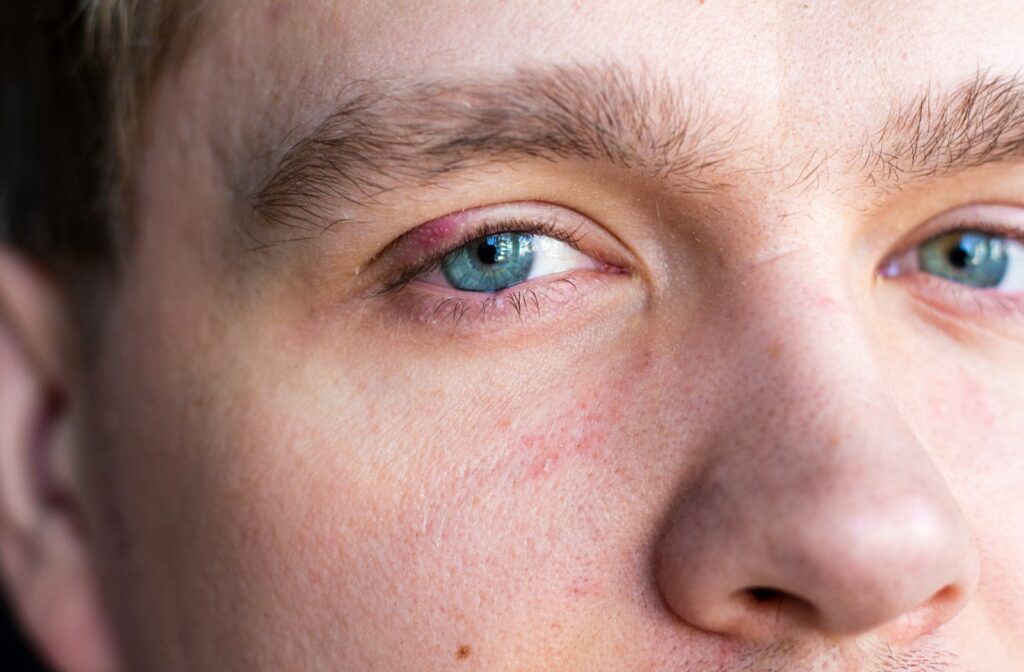Eye Problems: Styes
Eye problems are more than vision problems. The health of our eyes is affected by many things, from how well-rested we are to wearing eye makeup. Regular eye exams can help us protect our health and our sight. However, you can also visit an eye doctor for more than a routine checkup.
We can diagnose eye irritations, infections, and injuries. So if you notice eye redness or a growing lump—a stye—we can help. Styes are one of many common eye problems in children but can also occur in adults. Styes can be uncomfortable and irritating, but are they contagious?
What Is A Stye?
A stye or hordeolum is a painful, red lump that can grow at the base of your eyelash or under your eyelid. When a stye is small, it can appear similar to a pimple. A stye is similar to one type of pimple, a pustule or papule—an inflamed and infected pore caused by a clogged gland. Styes are caused by a bacterial infection in a clogged oil gland.
The bacteria in question is typically Staphylococcus aureus. It can be spread by touching our eyes through eye makeup, improperly cleaned contacts, blepharitis, or anything that increases eye rubbing, including allergies or tired eyes.
Symptoms of a stye may include:
- Tenderness
- Crusty eyelids
- Burning sensation
- Itchy eyes
- Blurry vision
- Discharge of mucus
- Light sensitivity
- Watery eyes
- Discomfort when blinking
- Feeling like something is in your eye
Styes typically are not contagious. The condition rarely requires antibiotics for treatment, but it can improve healing. If you experience a stye, you should book an eye exam. We can diagnose your eye health to confirm if it is a stye and ensure you receive appropriate treatment.
After the stye opens and drains, we can examine the area, evaluate healing, and recommend the next steps. If styes are a frequent problem, we can work with you for prevention options.
Styes and Your Child’s Eyes
Everyone knows a kid that picks at scabs or can’t resist poking their fingers where they don’t belong. Styes are more common in children because they’re less cautious about rubbing their eyes with dirty hands.
Preventing frequent eye-touching can be crucial when an eye problem is caused by bacteria or infection. It’s also important to teach children about cleaning the areas around their eyes. Eye hygiene can help keep your child’s eyes healthy.

Treating A Stye
Although styes can go away on their own, treating the stye can improve recovery. If you have more than one stye, it’s best to schedule an appointment so we can assess your eye health. Like a pimple, a stye will eventually come to a head and can be expressed.
Do not “pop” the stye. Popping, scratching, or squeezing the stye (before it’s ready), can cause complications, including:
- Spreading the bacterial infection
- Worsening infection inside the stye
- Causing scarring on the eyelid
- Creating pitting (holelike scar) on eyelid
You can encourage the stye to come to a natural head faster by using a warm compress. Place a comfortably warm, moist compress over the area for 15 minutes between 3–4 times a day. Your optometrist may also prescribe an antibiotic ointment to apply after the warm compress.
When the stye comes to a head, it can be gently expressed (squeezed). However, suppose the stye is large or deeply under the eyelid. In that case, an optometrist may need to lance the area to express the mucous membrane. Then, the patient (or optometrist) must carefully clean the eyelid. Additional treatment may also include ointment, used until symptoms have cleared.
Diagnosing Eye Health
Early diagnosis is crucial in preventing worsening eye symptoms, potentially spreading infections, or misdiagnosing with similar conditions. Patients may assess their eyes and assume they recognize the symptoms. But many symptoms can look identical to the naked eye.
For example, patients may see a swollen eyelid or redness and assume they have pink eye! Unfortunately, Styes can be misdiagnosed as conjunctivitis (pink eye). Pink eye is potentially highly contagious and can have serious health effects without treatment.
Optometrists have access to the tools and technology necessary to look beyond the surface appearance. Our team is trained to recognize the differences in conditions and diseases, improving our ability to provide accurate treatment.
We can also provide emergency eye care if your symptoms become painful or interfere with vision.
Contact Us for the Vivid Experience
Keeping your eyes healthy protects your vision. We’re here to provide professional advice about everything from styes to visual needs. Contact us if you have questions about your eye health, whether you’re experiencing symptoms or want to learn more about your unique eyes. Vivid Eye Care is committed to supporting quality vision for all our patients.
Book an appointment with Vivid Eye Care today!






















